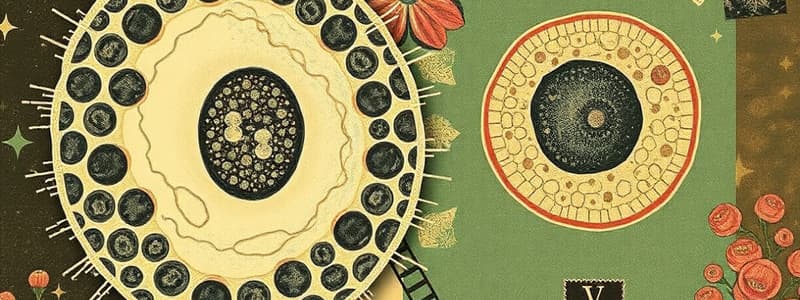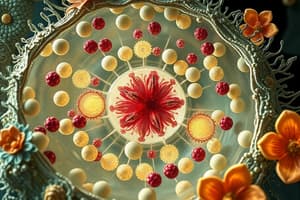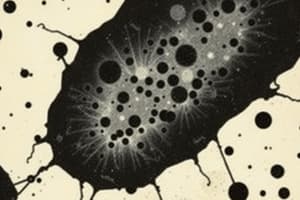Podcast
Questions and Answers
What is a defining characteristic of plant cells?
What is a defining characteristic of plant cells?
- Presence of chloroplasts and a cell wall (correct)
- Presence of small vacuoles
- Presence of lysosomes
- Absence of any vacuoles
Which of the following statements about animal cells is correct?
Which of the following statements about animal cells is correct?
- They contain cell walls made of cellulose.
- They have large vacuoles.
- They are characterized by small vacuoles or vesicles. (correct)
- They perform photosynthesis.
What is the primary function of chloroplasts in plant cells?
What is the primary function of chloroplasts in plant cells?
- Movement of molecules
- Photosynthesis and energy conversion (correct)
- Support and protection
- Cell division
What role does the cell wall play in plant cells?
What role does the cell wall play in plant cells?
How is magnification calculated?
How is magnification calculated?
What is the primary function of methylene blue dye in preparing human cheek cells?
What is the primary function of methylene blue dye in preparing human cheek cells?
Which step should be performed first when preparing a slide with human cheek cells?
Which step should be performed first when preparing a slide with human cheek cells?
What precaution should be taken while lowering the coverslip over the cheek cell sample?
What precaution should be taken while lowering the coverslip over the cheek cell sample?
When using a microscope, which objective lens should be selected first?
When using a microscope, which objective lens should be selected first?
What color will iodine stain cell nuclei?
What color will iodine stain cell nuclei?
What is the primary function of the mitochondria in both plant and animal cells?
What is the primary function of the mitochondria in both plant and animal cells?
Which structure is found in plant cells but not in animal cells?
Which structure is found in plant cells but not in animal cells?
What is the function of the vacuole in plant cells?
What is the function of the vacuole in plant cells?
Which of the following structures controls the activities of the cell?
Which of the following structures controls the activities of the cell?
Which component of the cell membrane controls what enters or leaves the cell?
Which component of the cell membrane controls what enters or leaves the cell?
What is typically true about the sap vacuole in plant cells compared to animal cells?
What is typically true about the sap vacuole in plant cells compared to animal cells?
What structure is primarily responsible for protein synthesis?
What structure is primarily responsible for protein synthesis?
Which of the following is NOT a similarity between plant and animal cells?
Which of the following is NOT a similarity between plant and animal cells?
What is the primary function of root hair cells?
What is the primary function of root hair cells?
Which statement describes xylem vessels?
Which statement describes xylem vessels?
How are root hair cells adapted for their function?
How are root hair cells adapted for their function?
What modification allows xylem vessels to support the plant effectively?
What modification allows xylem vessels to support the plant effectively?
Which of the following is NOT a characteristic of a modified cell?
Which of the following is NOT a characteristic of a modified cell?
What role does the finger-like projection of root hair cells serve?
What role does the finger-like projection of root hair cells serve?
In terms of organization, what level does 'tissue' refer to?
In terms of organization, what level does 'tissue' refer to?
What system is formed by a group of organs with closely related functions?
What system is formed by a group of organs with closely related functions?
What is a primary adaptation of muscle cells that allows them to perform their function effectively?
What is a primary adaptation of muscle cells that allows them to perform their function effectively?
Which structure in muscle cells is modified to aid in contraction?
Which structure in muscle cells is modified to aid in contraction?
What feature do red blood cells lack that differentiates them from other cell types?
What feature do red blood cells lack that differentiates them from other cell types?
What is the purpose of using iodine solution when preparing a slide of onion epidermis cells?
What is the purpose of using iodine solution when preparing a slide of onion epidermis cells?
What is the correct method for lowering the cover-slip onto the onion tissue during slide preparation?
What is the correct method for lowering the cover-slip onto the onion tissue during slide preparation?
How do muscle cells ensure they have enough energy for their functions?
How do muscle cells ensure they have enough energy for their functions?
What specific safety measure must be taken while doing dissections in practical work?
What specific safety measure must be taken while doing dissections in practical work?
What does the term 'magnification' refer to in microscopy?
What does the term 'magnification' refer to in microscopy?
Flashcards
Cell
Cell
The basic building block of all living organisms, responsible for carrying out life processes.
Cell Wall
Cell Wall
A rigid structure surrounding the cell membrane of plant cells, providing support and protection.
Chloroplasts
Chloroplasts
Organelles found only in plant cells, containing chlorophyll pigment, which captures light energy for photosynthesis.
Photosynthesis
Photosynthesis
Signup and view all the flashcards
Modified Cells
Modified Cells
Signup and view all the flashcards
Cytoplasm
Cytoplasm
Signup and view all the flashcards
Cell membrane
Cell membrane
Signup and view all the flashcards
Mitochondria
Mitochondria
Signup and view all the flashcards
Nucleus
Nucleus
Signup and view all the flashcards
Ribosome
Ribosome
Signup and view all the flashcards
Vacuole
Vacuole
Signup and view all the flashcards
Root Hair
Root Hair
Signup and view all the flashcards
Osmosis in Root Hair
Osmosis in Root Hair
Signup and view all the flashcards
Mitochondria in Root Hair
Mitochondria in Root Hair
Signup and view all the flashcards
Large Vacuole in Root Hair
Large Vacuole in Root Hair
Signup and view all the flashcards
Root Hair Secretion
Root Hair Secretion
Signup and view all the flashcards
Xylem Vessels
Xylem Vessels
Signup and view all the flashcards
Lignified Walls of Xylem
Lignified Walls of Xylem
Signup and view all the flashcards
Anaerobic Respiration
Anaerobic Respiration
Signup and view all the flashcards
Epithelial Tissue
Epithelial Tissue
Signup and view all the flashcards
Aerobic Respiration
Aerobic Respiration
Signup and view all the flashcards
Photosynthesis In Plants
Photosynthesis In Plants
Signup and view all the flashcards
Lack of Cross Walls, Cytoplasm, or Nuclei
Lack of Cross Walls, Cytoplasm, or Nuclei
Signup and view all the flashcards
High Mitochondrial Concentration
High Mitochondrial Concentration
Signup and view all the flashcards
Glycogen Storage
Glycogen Storage
Signup and view all the flashcards
Preparing Cheek Cells
Preparing Cheek Cells
Signup and view all the flashcards
Methylene Blue Dye
Methylene Blue Dye
Signup and view all the flashcards
Coverslip
Coverslip
Signup and view all the flashcards
Increasing Magnification
Increasing Magnification
Signup and view all the flashcards
Study Notes
Organisation of the Organism
- Living organisms are made up of many cells
- Cells are the fundamental units of living organisms
- Plant cells have chloroplasts, cell walls, and large vacuoles
- Animal cells have small vacuoles or vesicles
- Some cells are modified, including root hairs, muscle fibers, and xylem tissue
- Magnification is calculated by dividing the image size by the actual size
Cell Structure and Organization
- Plant Cell Structures
- Cell wall: Found only in plant cells, made of cellulose (non-living), supports and protects, and gives the cell shape
- Chloroplasts: Contain chlorophyll, traps light energy, convert it to chemical energy for photosynthesis, to form starch
- Vacuole: Fluid filled, surrounded by a membrane, contains salt and minerals, support and keep the cell firm.
- Structures found in both plant and animal cells
- Cytoplasm: Jelly-like substance with particles and organelles.
- Cell membrane: Partially permeable membrane, controls what enters and leaves cell, site of chemical reactions
- Mitochondria: Oval-shaped organelle, responsible for aerobic respiration
- Nucleus: Circular shape that contains DNA, controlling cell division and activity
- Ribosomes: Circular structure attached to the cell membrane, responsible for protein synthesis
- Animal Cell
- The text describes animal cells and their various structures and functions that enable them to perform their roles.
Similarities and Differences Between Plant and Animal Cells
- Similarities: Both have cell membranes, cytoplasm, nuclei, and mitochondria
- Differences:
- Plant cells have cell walls and large, permanent vacuoles; animal cells do not
- Plant cells usually have chloroplasts; animal cells do not
- Plant cells typically store starch; animal cells typically store glycogen
Levels of Organization
- Cell: The basic structural and functional unit of all organisms
- Tissue: Groups of similar cells that perform a specific function
- Organ: Groups of tissues that perform a specific function
- Organ system: Groups of organs that work together to perform a particular function
Modified Cells
-
Modification: Change in shape or structure to adapt to a specific function
-
Modified cells perform specialized functions different from their original roles
-
Examples of modified cells
- Root hair cells: Absorbs water and minerals
- Large number and finger-like projections to maximize surface area,
- Contains mitochondria for energy production,
- Large vacuoles for water absorption,
- Excrete viscous substances for water absorption and protection against soil particles.
- Xylem Vessels: Conducts water and minerals
- Fine tubes for capillary action,
- Lignified walls for support, and impermeability to water
- Absence of cross-walls, cytoplasm, and nuclei to minimize resistance to water flow,
- Pits for water and mineral distribution
- Root hair cells: Absorbs water and minerals
-
Muscle cells: Specialized cells for contraction in movement
- Contains many mitochondria for producing energy
- Stores carbohydrates in the form of glycogen
- Part of cytoplasm is modified for contractile filaments
Practical work: Preparing Slides
- Safety precautions for handling equipment and materials
- Plant cell preparation
- Preparing onion epidermis cells and staining them with iodine to view cell structures clearly. Steps include peeling an onion layer, placing it on a slide, adding iodine solution, covering with a cover slip, observing under the microscope
- Animal cell preparation
- Preparing cheek cells, staining with methylene blue to color nuclei, viewing under a microscope. Steps include rinsing your mouth, collecting cheek cells with a cotton bud, placing the sample on a slide, adding dye, placing the cover slip, and observing під microscope
Studying That Suits You
Use AI to generate personalized quizzes and flashcards to suit your learning preferences.




